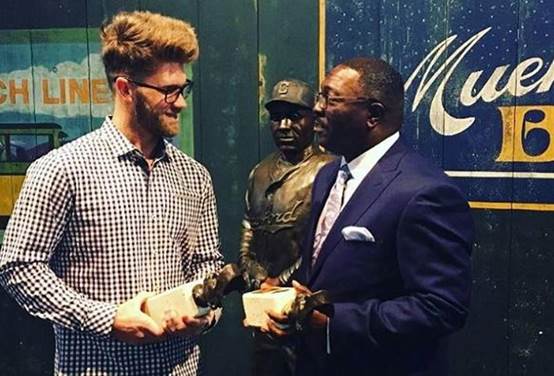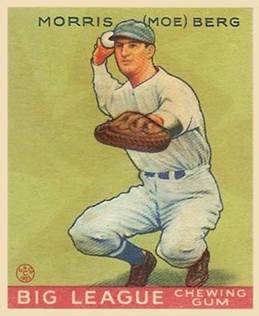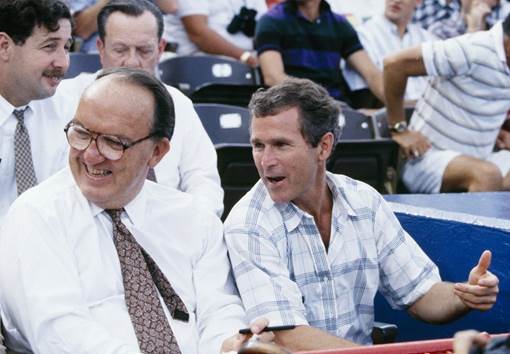With your permission, I won’t talk about the just-concluded series with the current Washington team. Let’s just go with the headline in the KC Star this morning: “Swarmed by Nats.”
NLBM and Bryce Harper: Manager Dusty Baker, Bryce Harper and several other players from the Nationals toured the Negro Leagues Baseball Museum this week. While there, Harper picked up two awards for his banner 2015 season: The Oscar Charleston Legacy Award for the MVP of the NL and the Josh Gibson Legacy Award for the most homers. Harper tweeted after the visit: “It was an honor and a pleasure going to the museum and learning about some of the greatest players to ever play this game! Josh Gibson still has the biggest forearms I have ever seen.” Harper included this Instagram photo with his tweet [Harper (what hair!) and Bob Kendrick, NLBM president, with Oscar Charleston looking on]:

NLBM and the Hall of Game: In 2014, the Negro Leagues Baseball Museum established the “Hall of Game” to honor MLB greats who competed with the same passion, determination, skill and flair exhibited by the heroes of the Negro Leagues. Last week, the 2016 inductees were announced and three of the four played for the “Washington” franchises. Andre Dawson and Tim Raines played for the Expos and Tony Oliva was a three-time AL batting champ for the Twins. The fourth inductee is Orlando Cepeda. All are scheduled to attend the induction ceremonies on June 11 in Kansas City.
Franchise Records for the Statistics Nerds: As discussed in Hot Stove #16, Washington has been home to three major league teams: Senators/Part 1 (1901-1960, off to Minnesota), Senators/Part 2 (1961-1971, off to Texas) and the Nationals (nee Expos, 2005 to present). The relocations have set up a bizarre franchise record system.
The stats from the original Senators moved with the team to Minnesota. So a Twins pitcher wanting to have a best franchise year or career of wins, strikeouts, etc. is in competition with Walter Johnson. Good luck.
As for the Senators (Part 2), those stats moved to Texas, but the short time period in DC and lack of big stars will find the franchise records mostly in the hands of Rangers players.
The Montreal Expo stats have moved to DC to be shared with the Nationals. Bryce Harper has a good chance to eclipse some of the hitting stats, but the Tim Raines stolen base record with the Expos will be safe for some time.
The Washington Catcher Was a Spy: The last time a Washington team was in the World Series was in 1933 (lost 4-1 to the Giants). The Senators’ backup catcher was Moe Berg, a name I knew because Wayne Tenenbaum told me about him years ago and recommended a biography: The Cather Was a Spy. Berg played parts of 15 seasons from 1923 to 1939, but almost always in a backup role. He had studied modern languages at Princeton and missed spring training a couple of years so he could get his law degree. Berg was fluent in eight languages, but as one teammate (or maybe Casey Stengel) joked, Moe could not hit in any of them. After the 1934 season, Berg traveled with some all-stars (including Ruth and Gehrig) to Japan. He snuck up to the top of a tall building and filmed the city and harbor, and his film was “reportedly” helpful in the Doolittle bombing raids on Tokyo. In WW II, Moe used his linguistic skills on assignments in Europe for the OSS, the forerunner of the CIA. The CIA confirms that Berg’s baseball cards are part of the CIA museum collection (click here).

Coming attraction for 2017: The movie version of The Catcher Was a Spy, starring Paul Rudd in the title role. Rudd is a very cool KC native who is one of the sponsoring stars for the annual Big Slick fund raiser for Children’s Mercy Hospital. He also narrated the 2015 World Series film and is a vocal national cheerleader for his hometown Royals.
Texas Rangers (nee Washington Senators) and The Making of the President, 2000: Last year, I read an interesting book that included an account of how George W. Bush moved along a path from managing general partner of the Texas Rangers to the presidency (The Game: Inside the Secret World of Major League Baseball’s Power Brokers by Jon Pessah). Bush invested $600,000 toward the $89 million purchase price to buy the Rangers franchise in 1989 (when the Rangers were sold in 1998, Bush netted $14.9 million). Bush served as managing general partner and was the public face of the team’s ownership group. He loves baseball and as a kid played little league, collected cards and memorized trivia.
There was talk of a run for Texas governor in 1990, but Bush threw himself into his baseball work and enjoyed it thoroughly. His advisor Karl Rove came to recognize that the popularity of the franchise was also good politics and would help cover any old negatives that might hurt a future campaign (business failures, youthful indiscretions, checkered military service). In a stroke of good fortune, Nolan Ryan had signed as a free agent with the Rangers four months before the Bush group bought the team. Ryan hurled his 6th and 7th no-hitters in 1990 and 1991 (the 7th being 18 years after his 1st – in KC against the Royals in 1973). With the growing success and popularity of the Rangers, Bush was well positioned for the 1994 governor’s race.
But Bush liked baseball a lot and when Fay Vincent was forced to resign as Commissioner in 1992, Bush had an interest in the post. Bush thought Milwaukee owner Bud Selig was supportive, but Vincent warned Bush to watch out for Selig. Vincent said he had been warned when he became Commissioner that Selig wanted the job. But Vincent thought Selig was his friend and ignored the warning. Vincent did not want Bush to make the same mistake. As time passed, Bush still wanted the job and awaited the right words from Selig. They did not come and it was time to move on. While Bush and Rove geared up for the 1994 governor’s race, acting Commissioner Selig presided over a season that ended in August with a player’s strike and without a World Series for the first time in 90 years. Bush had more success, winning the race against Ann Richards for governor and then on to the presidency in the 2000 election. But for Bud Selig, George Bush might have been the Commissioner of baseball and we would have missed the hanging chads, Bush v. Gore, Iraq, etc. I think Bush would have made a great Commissioner.

With Fay Vincent, 1990
Homestead/Washington Grays: The Homestead Grays were one of the most successful teams in the Negro Leagues. They started in 1912 in Homestead, a city near Pittsburgh. They moved to Pittsburgh in the 1920’s and in 1942 began playing some of their games in Washington. By 1943, the were playing over two-thirds of their games in DC and sometimes were called the Washington Grays. The top two stars for the Grays were catcher Josh Gibson and first baseman Buck Leonard who went into the Hall of Fame together in 1972 as the second and third members from the Negro Leagues. Satchel Paige of the KC Monarchs had been the first in 1971. Cool Papa Bell played five seasons with the Grays and went into the Hall of Fame in 1974.
Paul Simon, Joe DiMaggio and Cool Papa Bell: One of the most famous baseball lines comes from a song that is not about baseball – Simon and Garfunkel’s “Mrs. Robinson”: “Where have you gone, Joe DiMaggio, our nation turns its lonely eyes to you, woo, woo, woo…”. This past week, Paul Simon turned his eyes and lyrics to another center fielder, Cool Papa Bell of the Negro Leagues. Promoted as a summertime ode to Bell, “the fastest man on Earth did dwell as Cool Papa Bell,” this song is also not about baseball (click here).

Cool Papa Bell is said to have been the fastest man ever on the base paths, and a Satchel Paige story has enhanced that legend. While barnstorming in the late 30’s, Paige and Bell often shared a hotel room. Cool Papa bet Satchel that he could shut off the light and make it under the covers before the room was dark. Much to the amazement of Satchel, Cool did it, and the story became part of the repertoire when Satchel told tales of his days in the Negro Leagues. As told by Larry Tye in his bio Satchel, Cool told Satchel a half century later, a year before Satchel died, the rest of the story. Cool had arrived at the room earlier than Satchel and discovered that an electrical short in the light switch caused a three-second delay between flipping the switch and the light going dark. The story told all those years by Satchel was true, just not complete.
To paraphrase Paul Simon, “Joltin’ Joe and Cool Papa Bell have left and gone away, hey, hey, hey…”. But oh the memories.
Go Royals! Pretty please.